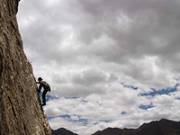|
|
||||
|
|
by Donald Levit  That standby critics’ blurb for direct-to-advertisement quote, “inspiring,” more often than not means “fluff,” but Blindsight happens to pull off one of those rare inspirational experiences. In part due to pure logistical or political paranoia issues, e.g., a critical Chinese hotel “house arrest” that shut down a father-and-son reunion after nine years, the documentary has wrinkles but is rewarding for the blind participants and for sighted audiences and, through an audio description track, the visually challenged. Without hammering things over the head, blind-in-one-eye director Lucy Walker contrasts and yet melds the sensations and thoughts of the eyeless in Tibet with those of their sighted guides, and also East and West, particularly their different conceptions of goals and the nature of success in reaching them. As we are to learn, the material summiting of a stated objective matters less than the quest in itself—Tennyson’s injunction to strive and not to yield is inscribed, after all, on the heroically “failed” Scott party In 2001, a year before mastering the last of each of the seven continents’ highest mountains, Colorado’s multi-field athlete Erik Weihenmayer became the first and still only blind person to climb Everest, bringing world fame and rôle model status among the blind. Soon afterwards he received an e-mail from Sabriye Tenberken, who like him had lost her sight before her teens. She had gone on to study Tibetology at Bonn, created the first Braille system for that country and, on her own, made the physically and politically arduous journey to Lhasa, where with her partner she located blind children for the school they set up as Braille Without Borders, Tibet’s only such institution. Her letter recounted the challenges faced by the pupils in an antagonistic area where Buddhism had been twisted to view the affliction as punishment for an evil previous life, or as a demonic possession, and the children had often lived horror lives out of nineteenth century asylum tracts. She had read his book to students, and invited him to visit them, perhaps to include a low-scale climbing workshop. Before flying over with associates -- the in-flight movie is Touching the Void (on which the current film’s mountain photographer Keith Partridge also participated) -- Weihenmayer considered the idea of more than just a safe workshop, of instead doing a real climb and, under difficult conditions, filming the venture. Six children fourteen to nineteen were chosen at Tenberken and partner Paul Kronenberg’s school for the Spring 2004 training course. Their names translating as “One Hundred Thousand Beautiful Lakes,” “Happy” and other jarring wishes, their painful rural backgrounds were filmed in a second shoot that fall, including an involved four-day journey to reunite Tashi (“Lucky”) with his Chinese family after nine years abandoned in the streets. There is also home-movie footage of Tenberken’s and Weihenmayer’s childhoods and the growth to surmount tragedies through determination and family support. Images of the usual unusual -- Barkhor Square, Jokhang, Potala, the dun high plateau and Himalayan glory -- are not given time to take away from the decided-on climb, well illustrated with red lines on clear contour maps. Beyond Rongphu Monastery, near north of Everest (indeed, passing through famous Base Camp), lay the 23,000-foot destination, “Stormy Mountain” Lhakpa Ri, 3,000 feet into the Death Zone, higher than any point outside the Himalayas and first scaled by legendary Mallory. The children have learned English and Chinese alongside Tibetan, and their voices are listened to. But it must be the adults who decide, Tenberken and the international professional mountaineering team, each acting as companion-guide to one of the six totally beginner youngsters. Added to the obstacles of language, backpack weight, altitude and feared acute mountain sickness, cold, wind, rockfalls, supply logistics (by yak), are those of the need for spoken directions about ledges and drop-offs, handholds and foot placement, crevasses, rocks in the path. Their boy and girl charges have distinct emotional as well as physical capabilities, and the grown Westerners in charge carry unspoken as well as open opinions as to objectives -- all the group, only some, or none at all; all the way, or not; the kids’ limits, or beyond. Danger increases with sickness and the weather prediction, and as personalities clash lightly, a decision on ultimate purposes must be taken. It will not do to reveal the outcome. But it should be said that the journey is well worth the watching. Bring your kids, who will have no trouble with the occasional, clearly readable boxed subtitles. Winning smiles convey more than words, anyway. (Released by Robson Entertainment; not rated by MPAA.) |
||
|
© 2025 - ReelTalk Movie Reviews Website designed by Dot Pitch Studios, LLC |



